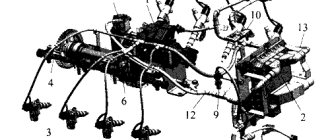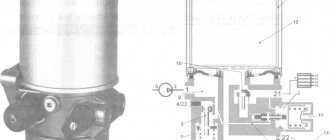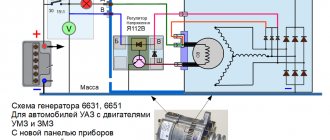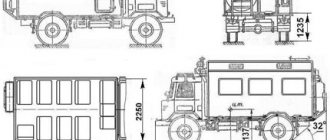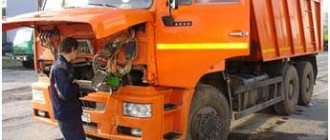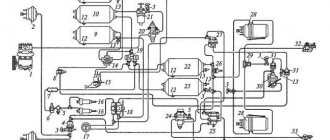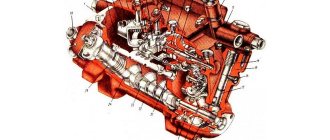— Fuel pressure check valve (OKDT) – device and functions
— Fuel pressure regulator (FPR) – design and functions
— The main signs of a malfunction of the check valve and fuel pressure regulator
A stable supply of fuel is critical for the normal operation of automobile engines equipped with an injection system (diesel, gasoline injection and carburetor engines). Malfunctions of the fuel system lead to unstable engine operation, loss of dynamics during acceleration, increased fuel consumption and increased emissions of harmful substances into the atmosphere. The ability to determine the presence of malfunctions in the fuel system and understand their possible causes greatly simplifies the life of any car owner.
Car enthusiasts often confuse a check valve and an RTD, especially since these devices are very similar in appearance and essentially perform the same function - maintaining fuel pressure in the vehicle’s fuel system, but each with its own characteristics. We will briefly describe the purpose and design of both of these devices, and also describe the main symptoms of their malfunction.
The role of the fuel regulator in the car system
At different engine operating modes, it is necessary to create the appropriate fuel pressure in the fuel system.
To implement this task in practice, a special pressure regulator is used. It is used in injection engines, where the correct operation of the engine depends on the accuracy of the injection parameters. When the governor is faulty, the engine runs unevenly, acceleration times are increased, and in some cases power can be significantly reduced. So, for example, if the amount of air coming from the manifold remains unchanged, and there is more fuel than necessary, the air-fuel mixture will not ignite or will not burn completely.
Even if in this mode the electronic control unit shortens the injector opening interval, it will not be possible to completely compensate for the excess fuel pressure. This will lead to interruptions in engine operation and an increase in the amount of unburned fuel in the exhaust, which can prematurely damage the catalytic converter or particulate filter.
Oil pump pressure reducing valve
The lubrication system is present on any car, be it a VAZ 2114 or a Mercedes. And any system must have an oil pressure reducing valve, regardless of its manufacturer - Bosch, Toyota or Volkswagen. If the lubrication system does not have such an oil valve, then when the oil pump is operating, a situation becomes inevitable when the oil pressure exceeds the established standards. Because of this, the oil seals will begin to leak or the oil filter may rupture.
The following figure will help you understand how such protection works:
The same approach as described above is implemented here. When the pressure exceeds the set safe limit, valve ball 2 opens an additional channel for oil flow and excess oil is discharged into the engine sump. Where is the pressure relief valve located? On a VAZ 2114 it is located in the channel between the compression and suction chambers, as shown in the photo
Installation locations
On cars, the injection system is equipped with a separate line for draining excess gasoline, which goes from the fuel rail to the gas tank (fuel recirculation). In such injectors, the regulator is installed directly on the fuel rail (or connected to it), so the unit quickly “reacts” to changes in engine operating conditions and adjusts the pressure in the rail. In this design of the power system, a mechanical type RTD is used.
There is another version of the injector - without gasoline recirculation. In this system there is no “return” at all, and regulation is carried out at the output of their fuel pump. A feature of such a system is the location of the regulator - in the tank or near it. An RTD is already used here, the operation of which is controlled by the ECU - the control unit, through a sensor installed in the ramp, monitors the necessary parameters and corrects them by sending signals to the regulator.
Power systems with electronic regulators are used less frequently than mechanical ones due to their complex design and, accordingly, lower reliability.
Operating principle of RTD
The valve design and operating principle depend on the type of fuel system of a particular vehicle. There are 3 ways to supply gasoline from the tank to the injectors:
- The pump together with the regulator is installed inside the tank; fuel is supplied to the engine through one line.
- Gasoline is supplied through one tube and returned through another. The fuel system check valve is located on the distribution rail.
- The circuit without a mechanical regulator provides for electronic control of the fuel pump directly. The system contains a special sensor that registers pressure; the pump performance is regulated by the controller.
In the first case, the return flow is very short, since the valve and electric pump are interlocked into a single unit. The RTD, located immediately after the supercharger, dumps excess gasoline into the tank, and the required pressure is maintained throughout the supply line.
The second option is used in most foreign cars. A valve built into the fuel rail allows excess fuel to flow into the return line leading to the tank. That is, 2 gasoline pipes are laid to the power unit.
There is no point in considering the third circuit - instead of a regulator, there is a sensor whose functionality is checked using a computer connected to the diagnostic connector.
A simple fuel pressure valve installed in the fuel pump unit consists of the following elements:
- cylindrical body with pipes for connecting the supply and return lines;
- a membrane connected to a locking rod;
- valve seat;
- spring.
The amount of pressure in the supply line depends on the elasticity of the spring . While most of the fuel goes into the cylinders (high load on the engine), it keeps the membrane and valve stem closed. When the crankshaft speed and gasoline consumption decrease, the pressure in the network increases, the spring compresses and the membrane opens the valve. The fuel begins to be discharged into the return line, and from there into the gas tank.
The fuel pressure regulator installed in the rail operates on a similar principle, but reacts faster to changes in load and gasoline consumption. This is facilitated by connecting an additional pipe of the element to the intake manifold. The higher the crankshaft speed and the vacuum on the spring side, the stronger the membrane presses the rod and closes the passage of fuel into the return line. When the load decreases and the speed drops, the vacuum decreases and the rod releases - the return flow opens and excess gasoline begins to be discharged into the tank.
Causes and Troubleshooting
If the above symptoms are detected, you should check the performance of the RTD using one of the suggested methods:
- measure the pressure in the fuel rail, its value should be at least 3 bar;
- find the return hose and carefully press it with pliers while the engine is running;
- disconnect the vacuum pipe leading from the manifold from the regulator.
The most reliable way is to measure with a pressure gauge. The device is connected to the fitting on the fuel rail, the test is performed with the engine running. If the pressure is below 3 Bar, additionally check the fuel pump - the unit may have lost performance. For diagnostics, you will need a tee with a pressure gauge embedded in the supply line. If the pump produces 3 Bar or more, change the RTD.
The reasons for valve failure look like this:
- the spring has lost its elasticity and allows the membrane to bypass fuel at low pressure;
- pollution with low-quality gasoline;
- rod jamming.
Due to the design features (the element body is rolled), repairing the fuel pressure regulator is impossible in most cases; the part will have to be replaced. The option of washing and blowing helps only with blockages inside the element.
Squeezing the return line is done at idle speed of the engine, preferably “cold”. If engine performance stabilizes, there is a problem with the RTD or pump. To determine the “culprit”, you will still need to measure the supply pressure. Try removing the vacuum tube from the manifold at higher speeds - if the valve has become unusable, the behavior of the power unit will not change.
Regulator design
The design of the mechanical fuel pressure regulator is simple. It consists of a body, which is internally divided by a membrane into two chambers. One of them is called the fuel chamber, the second is called the vacuum chamber (or simply vacuum). Each of the chambers is connected to the system components by fittings and channels. The fuel chamber is connected through channels to the fuel rail, and a fitting for the line for draining excess gasoline (“return”) also comes from it. The vacuum chamber also has a fitting, which is designed to connect to the intake manifold.
A needle valve is fixed to the membrane, the seat for which is the channel of the drain line fitting. This valve is constantly in the closed position, and a spring installed in the vacuum chamber presses it to the seat.
Symptoms of element failure
During the operation of the car, a car owner may encounter two types of RTD failure:
- The pressure drop in the rail is below the permissible level - the regulator directs most of the fuel through the return line to the gas tank.
- Increase in pressure to maximum - the element does not allow fuel to flow into the return line.
Note. As a rule, the first malfunction is accompanied by a rapid drop in pressure in the system after the electric fuel pump is turned off.
It is quite simple to track the signs of the first malfunction - the power unit is sorely lacking fuel for normal operation in all modes. Symptoms appear as follows:
- cold starting is difficult, the engine runs extremely unstable until it warms up;
- “dips” during acceleration and jerks when moving uphill;
- the car often stalls at idle;
- Gasoline consumption per 100 km increases.
The increased fuel consumption is explained by the actions of the driver trying to compensate for the lack of fuel mixture by pressing the accelerator pedal. Driving in this mode is quite difficult - it is better to immediately check the fuel pressure regulator for functionality.
When the valve does not allow excess fuel to flow into the tank, the following consequences are observed:
- Due to too high pressure from the ramp side, the injectors begin to leak and fill the cylinders with pure gasoline, and not with the working air-fuel mixture.
- The engine is bad, it emits black smoke from the exhaust, and sometimes you can hear popping noises in the exhaust manifold. The reason is flashes of unburnt fuel.
- Consumption increases noticeably.
- Leaks may be observed at the joints of the fuel pipes, and a strong gasoline smell may be felt.
Practical experience shows that a lack of fuel mixture occurs more often than an excess. That is, the most common problem with an RTD is the draining of gasoline into the return pipe and tank.
Video
Problems with the RTD: it doesn’t drive well, it doesn’t accelerate, it jerks.
How to check the fuel pressure regulator. Example on a BMW E34 (BMW E34).
How to measure the pressure in the fuel system on a VAZ 2110 car.
Violation of the integrity of the body
Poor quality fuel, the presence of foreign impurities in it and other negative factors contribute to the destruction of the hull. The device stops working normally. Detecting a small fluid leak is quite difficult. This is due to the fact that gasoline evaporates quickly. Smudges and stains form at the installation site.
If a violation of the integrity of the housing is detected, the product should be replaced immediately. A leak may cause a fire.
Diagnostics and malfunctions of the fuel regulator
Fuel pressure regulator
The design of the fuel pressure regulator does not allow for repairs. In some cases, it is cleaned, but this procedure does not briefly extend the life of the device. If a breakdown is detected, most often the regulator is completely replaced with a new one. The main types of faults of this unit are:
- sagging or breakage of the working regulator spring;
- depressurization of the housing;
- mechanical wear of contact surfaces;
- corrosion of various surfaces;
- channel contamination.
Direct malfunctions can manifest themselves in three formats:
- jamming - the regulator does not operate every time it is needed, but periodically;
- incomplete closure - fuel is constantly drained into the tank (return line), regardless of pressure;
- jamming in the closed position - fuel does not drain under any parameters.
Signs of a malfunctioning fuel regulator have much in common with fuel pump failures and dirty filters. Thus, preliminary diagnosis can be made based on the following observations:
- Unstable operation and engine stopping in idle mode.
- Increased fuel consumption.
- Reduced motor power.
- Slow response to pressing the throttle pedal.
- Lack of smooth movement when accelerating the car, jerking is observed.
- The content of harmful components CO and CH in the exhaust increases significantly.
- The car does not accelerate.
The quality of the fuel has a significant impact on the service life of the fuel pressure regulator. You should also not neglect the timely replacement of fuel filters. Particular attention should be paid to the fuel regulator if the car has not been in use for a long time.
Causes of malfunctions
There are not many reasons why the fuel regulator fails. The element cannot be called ultra-reliable; it works, as they say, under wear and tear, and is very dependent on the quality of the fuel.
Causes of breakdowns:
- Marriage. This is not a common reason, but sometimes you come across defective products from domestic automakers. It is recommended to check the spare part before purchasing.
- Wear. Usually observed after 100-200 thousand kilometers. In the regulator, the membrane becomes less elastic, the pressure control valve gets stuck, and the spring becomes weaker.
- Bad fuel. Gasoline and diesel car engine fuel often contains too much moisture, debris, and foreign toxins. Water in fuel causes rusting of the metal parts of the regulator. Increasing over time, they interfere with its normal functioning and lead to weakening of the spring.
- The fuel filter is clogged. Garbage fractions in the fuel clog the system, including the RTD, and become clogged. This leads to spring wear and valve jamming.
On a note!
RTDs are usually not repaired, but replaced with a new one. But, if the cause of the breakdown is clogging, it can be cleaned.
Failure options
The regulator is a simple device from a technical point of view, so there are few breakdowns that can happen to it. In almost all cases it is recommended to replace the RTD.
What can break:
- Spring. This is the main failure in the RDT. Due to the weakening of the spring, the engine becomes “starved”, there is not enough fuel at high speeds, when the clutch is pressed and during transient conditions.
- Pollution. When clogged, the ability to pass fuel is lost. The engine stops in any operating mode. If the RTD is heavily contaminated, the pressure in the vehicle rises sharply and fuel leaks through the sealing material. The problem is solved by pumping a large amount of fuel into the fuel pump.
- Jammed. The RTD in the ramp may periodically jam. The car twitches.
Preparatory work
- Take a tire pressure gauge and wrap flax or fum tape around the tip, this will prevent fuel spills and air leakage.
- Prepare a hose with a maximum internal diameter of 9 millimeters, and you will also need clamps for fastening. It is necessary to fix the hose on the pressure gauge and tighten everything with clamps.
- Place the prepared tool on the engine so that the hose and pressure gauge fixed on it do not roll off the surface. This will avoid fuel spilling on the engine.
- We unscrew the nipple spool on the ramp (fuel splashing is possible due to residual pressure).
- We put a hose with a pressure gauge on the ramp connections and secure everything with a clamp.
- Homemade pressure gauge for measuring pressure in the rail assembly.
Diagnostics
There are a number of methods to diagnose the condition. All of them are simple, even a novice car enthusiast can handle them.
Test methods:
- Visually. This is an option for carburetor engines. Pinch the valve or disconnect it. The fault can be determined by how intense the fuel flow is. The method is simple, but inaccurate.
- Pressure gauge. Install the device between the fitting and the hose, temporarily disconnecting the vacuum hose. The reading on the pressure gauge should rise to 0.7 bar.
- By pinching the hose. Check the RTD by clamping the return line. The pressure gauge should respond immediately. If the engine does not rev up, the governor is faulty. Start the engine by clamping the return line. Watch the speed and listen to his work. If its operation is uniform, the adjustment valve is faulty - it must be replaced.
The procedure for checking the performance of an RTD depends on its type - mechanical and electrical components are checked differently.
How to check a mechanical regulator:
- locate the fuel return hose under the hood;
- start the engine - let it run for a minute to warm up a little;
- using pliers - very carefully, pinch the return hose;
- if after clamping the engine begins to work well, then the problem is a broken RTD.
It is forbidden to pinch the hoses for a long time - this creates additional stress on the pump, which leads to its breakdown in the future.
In injection engines, fuel hoses are made of metal rather than rubber to increase reliability. Electrical sensors in such systems are made on the basis of strain gauges. To determine if the RTD on the injector is faulty, check the voltage at the sensor output.
In diesel engines, RTDs are checked by measuring the resistance of the sensor inductor. Usually the normal value is around 8 ohms. If the resistance is noticeably higher, or vice versa, much lower than stated, the regulator is broken. Detailed diagnostics are carried out only in the service center - at special stands where sensors and the entire fuel supply system are checked.
How to check the fuel pressure sensor
Depending on what fuel supply system is used for the car, there are three ways to check the sensor for functionality without dismantling the fuel rail:
- mechanical method for old-style cars with rubber fuel discharge hoses for gasoline internal combustion engines;
- multimeter;
- pressure gauge.
Dismantling the rack and subsequent diagnostics of the regulator is a more reliable way to check the quality of the mixture, since all adjacent components and wiring are checked together with the DDT. In most cases, diagnostics are carried out at a service station, since you will need to use a special stand. Self-diagnosis in the garage without dismantling the rack requires a tester and is carried out in 15 minutes.
Mechanical diagnostics of an old-style regulator
For gasoline internal combustion engines in which a rubber pipe is used in the fuel removal system, the sensor is located at the inlet of the pump. The check is carried out only on a cold engine.
- Start the engine.
- Remember the nature of its operation (a faulty sensor causes the motor to trip).
- Pinch the fuel outlet pipe with pliers for 1–3 seconds.
If the fault is in the regulator, the engine will restore its operation, the speed will become smooth, and jerking will disappear. If, after the outlet pipe is closed, the motor continues to operate incorrectly, the fault may be in clogged filters or worn contacts, although the sensor is working properly.
Diagnostics with a multimeter
Using a tester, they check the performance of the RTD and the quality of power from the block. Checking the electrical signal to the block is carried out in steps.
- Remove the block from the sensor.
- Set the multimeter to voltage measurement mode.
- Set the black lead of the tester to “minus”, attach the red probe to the connector of the block.
Repair and replacement of RTD
If your vehicle exhibits any number of symptoms of fuel regulator malfunction, diagnosing the fuel regulator is the only step toward returning it to proper operating parameters. In the event that a check indicates that the device is out of order, the following must be done.
Step 1. Remove the fitting plug to be able to control the pressure of the flammable liquid at its end.
Step 2. Using a special metal protective cap, carefully remove the spool from the inner cavity of the fitting.
Step 3. Reduce the pressure in the power system, and then carefully remove the vacuum hose from the device.
Step 4. Remove the nut used to secure the fuel supply tube.
Step 5. After the two bolts that secure the module to the fuel frame are unscrewed, you need to smoothly remove the fitting from their holes.
Step 6. Carefully remove the RTD.
As a rule, the removed device cannot be repaired, and it is replaced with a new, more functional one. You can purchase a module with delivery either in any specialized store or via the Internet.
Conclusion
The injection pump pressure reducing valve is one of several valves in diesel fuel systems, which is responsible for the normal operation of the entire power unit. If it fails, the car owner is immediately faced with several problems that will make operating the vehicle very difficult. Despite their rather simple design, such valves do not very rarely fail. Often the problem can be diagnosed by the car owner himself, but we recommend seeking qualified help from a diesel systems specialist. If the problems are related specifically to the pressure reducing valve, then you will not need to allocate a significant budget to purchase and install the spare part.
Source
